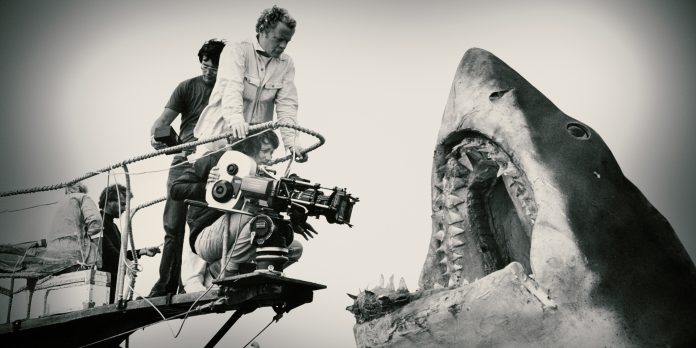THE STORY – A tribute to “Jaws” (1975), the movie that sparked a lasting fascination with the ocean’s most misunderstood predator.
THE CAST – Steven Spielberg, Janet Maslin, Cameron Crowe, Greg Nicotero, James Cameron, J.J. Abrams, Guillermo del Toro, Steven Soderbergh, Emily Blunt, Robert Zemeckis, Quentin Tarantino, Jordan Peele, George Lucas, Martin Scorsese, Francis Ford Coppola, Richard D. Zanuck & John Williams
THE TEAM – Laurent Bouzereau (Director/Writer)
THE RUNNING TIME – 88 Minutes
Sharks can live a long time. The Greenland shark has the longest known lifespan of any vertebrate species, with some living up to 400 years. Comparatively, Steven Spielberg’s “Jaws“ is young at 50 years old, but a lot has happened for the acclaimed filmmaker in the five decades since its release. “Jaws“ was his second theatrical film (third if you count the international release of the American TV film “Duel”). Between 1975 and now, Spielberg has won two Oscars for Best Director (“Schindler’s List“ and “Saving Private Ryan”), helped launch his own film studio, and directed some of the highest-grossing and most well-regarded films of all time. If you asked the average person on the street to name a film director, Spielberg would very likely be most people’s first pick. In honor of the recent 50th anniversary, documentarian Laurent Bouzereau (“Music by John Williams“) has made “Jaws @ 50: The Definitive Inside Story.“ Is his inside look worthy of such a lofty subtitle? While the film may not reveal many new insights into the making of the film to anyone who’s already read the IMDb trivia page for “Jaws,” it’s an enjoyable look at one of the greatest films ever made and a portrait of a genius filmmaker at the very beginning of his career.
Bouzereau makes the wise choice of telling the story of “Jaws“ in linear order, as if the audience is following along during the actual creation of the film itself. It begins even before the film was put in development, with the writing and publication of Peter Benchley’s novel, which served as the source material. From there, Bouzereau charts the film’s journey through pre-production, the notoriously difficult shoot, the assembly of the film in post-production, and the movie’s legendary success upon release. To help narrate this story, Bouzereau uses interviews with as many living people as possible who were involved, from descendants of featured actors still residing on Martha’s Vineyard (where the movie was filmed) to heavy hitters like composer John Williams and Spielberg himself. And to fill in the gaps, archival interviews are used of those who are no longer with us, like Robert Shaw (seeing him speak with an English accent while done up like Quint is hilariously shocking), and also those who are still alive, like Richard Dreyfuss (if anyone is unsure as to the possible reason why a new interview with him wasn’t conducted, take a look at his Wikipedia page). But best of all, Bouzereau manages to score interviews with some of the greatest living filmmakers, who use the chance to discuss what makes the film so important. This impressive roster of interviewees includes J.J. Abrams, James Cameron, Cameron Crowe, Guillermo del Toro, Jordan Peele, Steven Soderbergh (wearing a “Jaws“ shirt like the film dork he is), and Spielberg’s friend Robert Zemeckis.
The difficult production of “Jaws“ is well-documented. Knowing how tough it was to get the film made and what they had to overcome to simply complete it makes watching it even more enjoyable. And not only did boundless technical difficulties not stop them, but it even made the film better because it required creative solutions. Everyone knows that the shark animatronic didn’t work – there was even a recent Broadway play called “The Shark is Broken“ that detailed the making of the film, co-written by Robert Shaw’s son, Ian. Famously, the mechanical shark was built for freshwater and experienced severe issues when placed in saltwater at the filming location. “Jaws @ 50“ goes into this in detail, showcasing the creation of the shark and, hilariously, behind-the-scenes footage of it comically malfunctioning. As Spielberg says, “There was nothing fun about making Jaws…80% of the time the shark didn’t work.“ Later in the documentary, he shares a surprisingly moving anecdote about the difficulty he experienced in mentally recovering from the stress of making the film, including a visit to the original boat used in filming, which sat on the Universal lot, as a form of therapy. Spielberg isn’t precious about sharing his perspective on the making of the film, even revisiting the infamous footage of him being snubbed for a Best Director nomination by the Academy Awards.
Notably, the documentary also examines the ways in which “Jaws“ altered the public’s perception of sharks, particularly great whites. Unfortunately, the success of the book and film wasn’t very good for the animals themselves, who became the victims of an uninformed, fearful public. Shark experts and scientists are interviewed, sharing facts about sharks and telling hopeful stories about successful conservation efforts.
At the start of “Jaws @ 50,“ Spielberg is asked, “Is there anything that you’ve never said about Jaws?“ to which he laughingly responds, “Let’s find out!“ And while the documentary features valuable footage and interviews, film nerds are unlikely to learn much that they didn’t already know. Still, the film is essentially a feature-length version of the types of deep dive DVD bonus features (of which Bouzereau has directed many) or TCM documentaries that many of us grew up watching, which helped form our love of film. And the ratio of on-set drama to it-was-worth-it success for “Jaws“ is possibly the highest in film history, meaning “Jaws @ 50“ tells an entertaining and consistently fascinating true Hollywood story. If nothing else, it will make viewers want to watch “Jaws“ for the 50th time immediately after the documentary ends, and a rewatch of “Jaws“ is always a swimmingly good idea.


